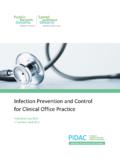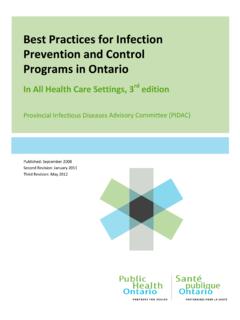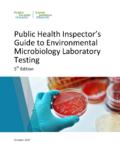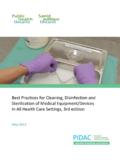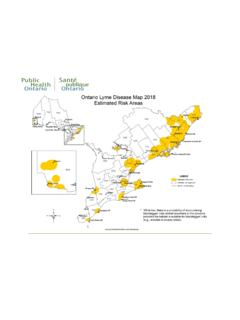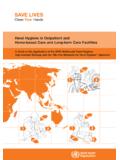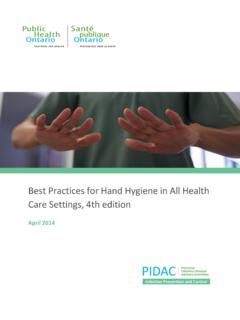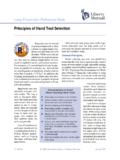Transcription of Your 4 moments for hand hygiene for long-term care homes
1 Version Your 4 moments for hand hygiene for long-term Care homes 2 Perfoming hand hygiene : when and how Overview: of when to clean hands . of two methods for cleaning hands and the importance of technique in reducing the spread of infections and maintaining skin integrity training for staff on the essential moments for hand hygiene -Your 4 moments for hand hygiene high-level overview of the observational audit process 3 Note: The term staff includes anyone conducting activities in the long-term care home. It is recommended that the hand hygiene Education module also be completed by staff. Available at 4 Did you know? Health care associated infections (HAI) are the most common serious complication of hospitalization. Health care associated infections were the 11th leading cause of death two decades ago, but are now the fourth leading cause of death for Canadians (behind cancer, heart disease and stroke).
2 In a long-term care home, the median cost associated with methicillin-resistant Staphylococcus aureus (MRSA) infection can be almost two times higher than the cost of a methicillin-sensitive Staphylococcus aureus infection. A recent study at Sunnybrook Health Sciences Centre, Long Term Care, in Toronto demonstrated the higher the hand hygiene compliance rate the lower the norovirus attack rate. A study showed it cost $12,061 CAD to control a VRE outbreak in a long-term care home. 5 Did you know? An increase in hand hygiene adherence of only 20 per cent results in a 40 per cent reduction in the rate of health care associated infections. (McGeer, A. hand hygiene by Habit . Infection prevention: practical tips for physicians to improve hand hygiene . Ontario Medical Review, November 2007, 74). Most staff working in health care settings believe they are already practicing good hand hygiene .
3 The observational audits from the Just Clean Your hands testing in Ontario showed a baseline general compliance rate of: <40%* *The pilot study also showed that compliance rates must be broken down into each moment and by the type of care provider to ensure reliable comparative data The power to make a difference is in your hands . 6 Why does perception and practice differ? Staff generally clean their hands when they are visibly soiled, sticky or gritty, or for personal hygiene purposes ( after using the toilet). Usually these indications require handwashing with soap and water. This habit is frequently learned in early childhood. Other hand hygiene indications unique to health care settings are not triggered by the habit to clean the hands . Highlighting these indications in health care are needed to create new habits.
4 Adapted from 7 hand hygiene in health care Staff move from one resident area to the next resident s area while providing care. This movement while carrying out tasks and procedures provides many opportunities for the transmission of organisms on hands . 8 Transmission of organisms Transmission of organisms by hands of staff between two residents can result in health care associated infections (HAIs). Adapted from the Swiss hand hygiene Campaign 9 Why does hand hygiene work? Adapted from the Swiss hand hygiene Campaign hand hygiene with alcohol-based hand rub correctly applied kills organisms in seconds. hand hygiene with soap and water done correctly removes organisms. 10 How to clean hands : Two methods Two Ways to Clean HandsTwo Ways to Clean HandsHandwashing with soap and running water must be done when hands are visibly soiled.
5 If running water is not available, use moistened towelettes to remove the visible soil, followed by alcohol-based hand rub. Alcohol-based hand rub is the preferred method for cleaning hands . It is better than washing hands (even with antibacterial soap) when hands are not visibly soiled. 11 Technique matters Keep nails short and clean Remove rings and bracelets Do not wear artificial nails Remove chipped nail polish Make sure that sleeves are pushed up and do not get wet Clean hands for a minimum of 15 seconds Dry hands thoroughly Apply lotion to hands frequently It is important that skin on hands remain intact to reduce the spread of organisms. To clean hands properly: rub all parts of the hands with an alcohol-based hand rub or soap and running water. pay special attention to fingertips, between fingers, backs of hands and base of the thumbs.
6 12 Product at Point of Care in the right place Busy staff need access to hand hygiene products where resident/resident environment contact is taking place. This enables staff to quickly and easily fulfill the 4 moments for hand hygiene . Providing alcohol-based hand rub at the point of care ( , within arm s reach) is an important system support to improve hand hygiene . Point of care can be achieved in a variety of methods. ( , ABHR attached to the bed, wall, equipment, and/or carried by the staff) Point of care - refers to the place where three elements occur together: the resident the staff care involving contact is taking place 13 Product placement: -analysis of workflow, risk assessment, maintenance Consider: Workflow patterns so it is easily accessible. Safety Resident population Dispensers not protruding or leaking Fire regulations Occupational Health and Safety recommendations Glove donning and removal Waste basket placement Use a testing phase to verify placement is correct Identify responsibilities for maintaining system Ongoing verification system is effective and maintained For more information refer to: - Placement Tool for hand hygiene Products.
7 14 When should hand hygiene be performed? Before preparing, handling, serving or eating food After personal body functions Before putting on and after taking off gloves Whenever a staff is in doubt about the necessity for doing so In addition to the above indications for hand hygiene , there are some essential moments in health care settings where the risk of transmission is greatest and hand hygiene must be performed. This concept is what Your 4 moments for hand hygiene is all about. 15 When to Clean hands Resident room: This is in the resident s area. In a single room this is everything in the resident s room. In a multiple room, this is everything in the immediate proximity to the resident. In the resident s room, staff, volunteers and family members are to clean hands following Your 4 moments for hand hygiene Shared activities: In common areas where residents gather, the environment is shared by many people.
8 To reduce spread of organisms, everyone is to clean hands before beginning and after ending the activity. Some residents may need help cleaning their hands before they begin and after they end an activity. If staff, volunteers or families provide any direct care where shared activities occur, the 4 moments for hand hygiene are to be followed. 16 When to Clean Direct Care Direct care is defined as providing hands -on care such as: bathing, washing, or turning a resident; changing clothes or providing continence care; changing dressings and caring for open wounds/lesions; and toileting. If direct care is provided in shared activities, the 4 moments for hand hygiene are to be followed. 17 Definition of Resident s Room 18 Your 4 moments For hand hygiene Activity: View Scenario DVD Main Menu Your 4 moments for hand hygiene Clean your hands when entering before touching the resident or any object or furniture in the resident s environment.
9 To protect the resident/ resident environment from harmful organisms carried on your hands . Clean your hands immediately after an exposure risk to body fluids (and after glove removal). To protect yourself and the health care environment from harmful resident organisms. Clean your hands immediately before any aseptic procedure. To protect the resident against harmful organisms, including the resident s own organisms, entering his or her body. Clean your hands when leaving after touching resident or any object or furniture in the resident s environment. To protect yourself and the health care environment from harmful resident organisms. 19 Examples of this indication in the resident s room Some examples may be: shaking hands , stroking an arm helping a resident to move around, get washed, giving a massage taking pulse, blood pressure, chest auscultation, abdominal palpation Activity: View Scenario DVD Main Menu Training Scenarios 1a, 1b, 1c, 1d 20 Examples of this indication in the resident s room Some examples may be: oral/dental care, giving eye drops, secretion aspiration skin lesion care, wound dressing, subcutaneous injection catheter insertion, opening a vascular access system or a draining system preparation of medication, dressing sets Activity: View Scenario DVD Main Menu Training Scenarios 2a, 2b 21 Examples of this indication in the resident s room Some examples may be.
10 Oral/dental care, giving eye drops, secretion aspiration skin lesion care, wound dressing, subcutaneous injection drawing and manipulating any fluid sample, opening a draining system, endotracheal tube insertion and removal clearing up urine, faeces, vomit, handling waste (bandages, napkin, incontinence pads), cleaning of contaminated and visibly soiled material or areas (bathroom, medical instruments) Activity: View Scenario DVD Main Menu Training Scenarios 3a, 3b, 3c 22 Examples of this indication in the resident s room Some examples may be: shaking hands , stroking an arm helping a resident to move around, get washed, giving a massage taking pulse, blood pressure, chest auscultation, abdominal palpation changing bed linen monitoring alarm holding a bed rail clearing the bedside table Activity: View Training DVD Main Menu Training Scenarios 4a, 4b, 4c 23 hand hygiene and Glove Use The use of gloves does not replace the need to clean hands .

